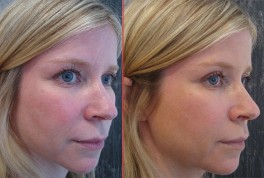
Brown spot creams
Liver spots, brown spots, age spots: an almost inevitable sign of aging. Anti-aging products make a lot of big promises, but do they give results? We take a look at some brown spot lightening creams to see if any stand up to an A&K test.
The Problem
If you’re like most people, you’ve spent a lot of time out in the sun and haven’t always been diligent about slathering on the sunscreen. As you age, darkened patches of skin can appear anywhere on your body that has had prolonged, unprotected exposure to the sun’s damaging UV rays. Most noticeably on your hands, and your face.
Brown spots, age spots, liver spots, or solar lentigo. All are terms used to describe these unsightly patches of darkened skin in which large concentrations of melanin pigment occur. (And no, they have nothing to do with your liver.)
Brown spots are typically smooth and look like your regular skin, other than the darker colour. Though they are aesthetically undesirable, they are usually no cause for concern. However, it is important to note any skin discolourations you may have that are raised, itchy, or tend to change shape. If you notice unusual patches like this, consult your doctor as they could be signs of skin cancer.
The (Potential) Solution
Brown spot removal creams are part of the growing arsenal of anti-aging products available on the market these days. They use various combinations of chemical ingredients that all aim to lighten the dark patches of skin in one way or another.
(There are also many recipes available for home remedies including ingredients like lemon, castor oil, onion, and vinegar, but we’ll leave those to you to look up and try on your own, if interested.)
Many over-the-counter creams make great claims about their brown-spot-reducing properties, including reducing discolourations, creating more uinform skin tone, moisturizing, anti-oxidizing, and texture-improving, among other things. Most creams are meant to be applied once or twice daily on target areas and require weeks or months to show results.
There are also prescription creams available through consulting with a dermatologist. These creams have hydroquinone as the active ingredient and should only be used under the guidance of a professional. Some over-the-counter creams also contain hydroquinone, but they will only be at 2% maximum. A prescription can get you a higher concentration (not more than 4%).
Buying Tips
Look for products that have opaque packaging since exposure to the sun can deteriorate the active ingredients in many creams.
Safety Precautions
Products with hydroquinone aren’t recommended for dark skin types since it can cause a condition called Ochronosis, in which the skin darkens, thickens, and develops yellow, grey, or brown spots.
Other side effects may include mild burning, stinging, itching, redness, or irritation.
These products are not recommended for use on dry, irritated or sore skin.
Most of these products can make your skin extra sensitive to sunlight as you’re using them, so it’s very important to wear an SPF at all times. (Even cloudy days.)
TEST CRITERIA
We selected two of the many brown spot lightening products available on the market and put them up against a prescription cream.
|
Our test products: |
. | BUY IT | |
Nars Lightening Cream: $98
|
. . | — |
|
Olay Professional Pro X Discolouration Fighting Concentrate: $55
|
. . | Well.ca | |
Ultraquin: $60
|
. . | By prescription | |
|
|||
Skin Test
We invited some viewers to help us test these creams. We each tried two types of creams on our hands and faces and applied them as directed religiously for 3 months.
-
The Olay Pro X claims you’ll see results in 30 days. None of our testers saw any improvement. We think it’s a waste of $50.
-
The Nars Lightening Cream was considered a good, moisturizing night cream, but again, none of our testers saw an improvement.
- The Ultraquin prescription formula worked the best on our testers, on Anna’s light skin especially.
OUR TOP PICK
If you’re serious about lightening your brown spots, consider seeing a dermatologist for a prescription strength cream like Ultraquin. Otherwise look for products with Retinol-A and 2-4% Hydroquinone. Also, remember to wear sunscreen everyday, but especially when you are treating your brown spots.










